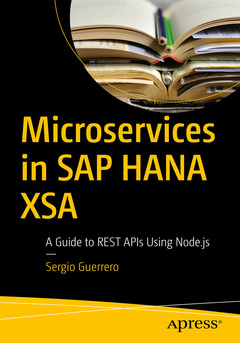Microservices in SAP HANA XSA, 1st ed. A Guide to REST APIs Using Node.js
Auteur : Guerrero Sergio

Build enterprise-grade microservices in the SAP HANA Advanced Model (XSA). This book explains building scalable APIs in XSA and the benefits of building microservices with SAP HANA XSA.
This book covers the cloud foundry (CF) architecture and how SAP HANA XSA follows the model. It begins with the details of the different architectural layers of applications hosted in XSA (specifically, microservices). Everything you need to know is presented, including analyzing requests, modularization, database ingestion, building JSON responses, and scaling your microservices. You will learn to use developmental tools such as the SAP WEB IDE, POSTMAN, and the SAP HANA Cockpit for XSA, including debugging examples on SAP HANA XSA with code snippets showing how microservices can be developed, debugged, scaled, and deployed on SAP HANA XSA. Microservices are divided into security and authentication, request handling, modularization of Node.js, and interaction with the SAP HANA database containers and response formatting. An end-to-end scenario is presented of a Node.js REST API that uses HTTP methods, concluding with deploying an SAP HANA XSA project to a production environment.
This book is simple enough to help you implement a Node.js module in order to understand the development of microservices, and complex enough for architects to design their next business-ready solution integrating UAA security, application modularization, and an end-to-end REST API on SAP HANA XSA.
What You Will Learn
- Know the definition and architecture of cloud foundry and its application on SAP HANA XSA
- Understand REST principles and different HTTP methods
- Explore microservices (Node.js) development
- Database interaction from Node (executing SQL statements and stored procedures)
Who This Book Is For
Architects designing business-ready solutions that integrate UAA security, application modularization, and an end-to-end REST API on SAP HANA XSA
Chapter Goal: The goal is to explain the SAP HANA XSA architecture, complexity of cloud foundry and the required artifacts on XSA. It paints the story for the rest of the book
Sub -Topics
1. Assumption and description of developers understanding SAP HANA 1
2. Cloud Foundry
3. Open Source4. MTA.yaml
Chapter 2: Tools for Development on HANA XSA
Chapter Goal: This chapter showcases the different tools involved for an XSA API project. Identifying the tools, capabilities and limitations allowing developers to become more productive.
Sub - Topics:
1. SAP WEB IDE and connecting to GIT
2. Database explorer (assuming we have a table, a data model and stored procedures)
3. XSA cockpit
4. POSTMAN REST client
Chapter 3: Security Model on XSA
Chapter Goal: Developers need to understand why the container isolation is required. Understanding containers allow developers to feel more comfortable during XSA development and it also facilitates the understanding while debugging
Sub - Topics
1. UAA service
2. OAuth2
3. CUPS (User Provided Services)
4. Cross schema access using synonyms
Chapter 4: SAP HANA XSA NodeJS Development
Chapter Goal: this chapter contains examples building REST APIs. It is the fundamental chapter to expose and ingest data into an SAP HANA XSA system via HTTP(s)
1. Compatibility mode with XSJS
2. Development of REST APIs
3. Node dependencies
4. Debugging NodeJsChapter 5: Deployment Scenarios of HANA XSA
Chapter Goal: A software product is not completed until it is deployed to a production environment. This chapter explains how to deploy an XSA project
Sub - Topics:
1. Mta project and versioning
2. WEB IDE deployments
3. Scaling microservices via the SAP HANA Cockpit for XSA
Explores microservices architecture on SAP HANA XSA
Shows you how to debug Node modules and stored procedures
Teaches different approaches for unit testing your APIs
Covers how to build full APIs, with examples using Node.js
Presents deployment scenarios for your microservices
Date de parution : 08-2020
Ouvrage de 222 p.
15.5x23.5 cm
Disponible chez l'éditeur (délai d'approvisionnement : 15 jours).
Prix indicatif 52,74 €
Ajouter au panierThèmes de Microservices in SAP HANA XSA :
Mots-clés :
microservices; NodeJs; Rest API; SAP; HANA XSA; Cloud foundry architecture



